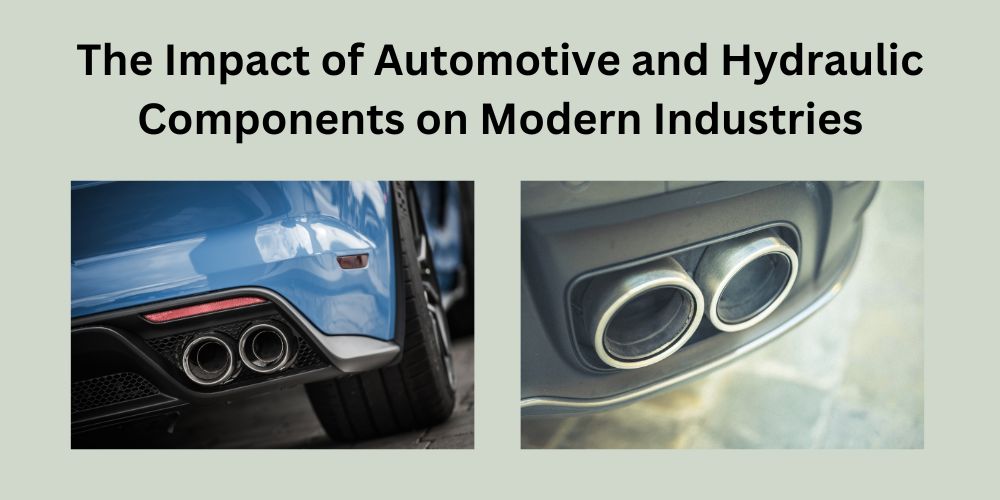It is impossible to underestimate the importance of automobile and hydraulic components in today’s corporate environment. These essential components fuel the effectiveness, security, and regular operation of several devices and systems throughout many sectors. Forged components in automotive are particularly critical, ensuring durability and performance. These additives are the foundation of harsh mechanical activities, whether they are found in, heavy machinery, hydraulic systems, or everyday consumer items. The significance, potential, and How hydraulic and automotive additives are shaping the modern industry we are going to answer in this article.
What Are Automotive and Hydraulic Components?
Before diving into the info in their effect, permit’s define what we imply by means of automobile and hydraulic components. Automotive additives are the components that make up cars, along with engines, transmissions, brakes, and suspension systems. Hydraulic components, on the other hand, are components utilized in structures that rely on pressurized fluids to generate force and motion. These encompass pumps, valves, cylinders, and hoses. Together, they power many machines that play a pivotal role in various industries.
Enhancing Efficiency and Productivity
One of the most sizeable affects of car and hydraulic additives is how they improve performance and productiveness. In the transportation industry, vehicles with advanced car systems can operate for longer intervals with minimal preservation. Modern engines and transmissions are designed to be extra fuel-green and durable, allowing for better overall performance with reduced downtime. This method goods can be transported more efficaciously, lowering prices for agencies and improving normal supply chain performance.
In hydraulic structures, the efficiency lies inside the clean and particular manage of movement. For instance, in the construction enterprise, hydraulic excavators and cranes can raise heavy loads effects, increasing work pace and lowering hard work charges. These structures are designed to maximise output whilst minimizing power intake, making sure that industries can perform more sustainably.
Powering Innovation in Construction
The production enterprise has benefited notably from improvements in hydraulic technology. Bulldozers, excavators, and cranes are all powered via hydraulic structures that permit for particular control and excessive-power output. These machines have transformed how homes, roads, and infrastructure initiatives are completed. They can cope with the toughest substances, making it easier to assemble in even the maximum tough environments.
What makes hydraulic additives so vital in creation is their reliability. These machines operate below extreme conditions—lifting heavy loads, operating long hours, and withstanding harsh climate. Hydraulic components are designed to be durable and resilient, reducing the frequency of repairs and downtime. The result? Faster production instances and cost financial savings for undertaking managers.
Transforming Agriculture
In the agriculture area, each automotive and hydraulic components play a pivotal position in contemporary farming strategies. Tractors, integrate harvesters, and plows are important equipment for farming, and these depend upon robust automotive structures to feature smoothly. These machines have made it possible to cultivate larger areas of land in much less time, notably improving crop yields and decreasing manual hard work.
Hydraulic structures additionally contribute heavily to precision farming. Machines equipped with hydraulics can manage planting, fertilizing, and harvesting with terrific accuracy, ensuring that assets are used optimally. This has not handiest expanded meals production however has additionally helped farmers lessen waste and enhance sustainability. In an age where environmental effect is a developing problem, having machinery that works smarter, now not harder, is a game-changer for agriculture.
Driving the Energy Sector
The strength zone, mainly renewable strength assets like wind and solar energy, relies on automotive and hydraulic components for efficient operation. Wind mills, as an example, use hydraulic systems for controlling the blades and optimizing their rotation pace, ensuring most strength generation. Automotive additives are also imperative to the preservation and transportation of these structures, making sure they can be deployed in numerous locations and maintained effectively.
In traditional energy sectors like oil and gasoline, hydraulic systems are used for drilling and pumping, at the same time as heavy-obligation vehicles geared up with advanced automotive systems transport sources across enormous distances. Without these additives, it would be tough to fulfil the developing demand for energy.
Safety and Reliability
Safety is a top precedence in industries like transportation, production, and strength. Automotive and hydraulic additives are engineered with safety capabilities that make certain machines perform properly and reliably beneath traumatic conditions. For example, hydraulic systems in construction system include fail-secure mechanisms that prevent risky malfunctions. Similarly, car structures in motors are designed with advanced braking systems, airbags, and balance controls to shield operators and employees.
Reliability is equally vital. Machines that use those additives are predicted to carry out always without frequent breakdowns. This level of reliability ensures that industries can hold to operate with out highly-priced interruptions, helping groups preserve their bottom line.
Supporting Environmental Sustainability
Another essential component of car and hydraulic additives is their contribution to sustainability efforts. Modern additives are designed to be energy-efficient, lowering the overall carbon footprint of machines. For example, gas-green engines in vans lessen greenhouse gasoline emissions, whilst hydraulic structures in production system use much less energy to perform the same responsibilities as older systems. As industries attempt to fulfill environmental guidelines and decrease their effect on the earth, those components will retain to play a crucial function in achieving sustainability goals.
What Are the Difficulties in Updating to Accept Hydraulic Components?
Complex Integration with Existing Systems: Many industries depend on traditional mechanical structures that are not designed to accommodate hydraulic additives. Updating these structures requires extensive modifications, which may be both time-ingesting and pricey.
High Initial Investment: Installing hydraulic structures often entails purchasing new equipment or retrofitting current machinery. This initial monetary outlay may be a main hurdle, in particular for smaller businesses or industries with tight budgets.\
Need for Specialized Training: Operating and preserving hydraulic structures requires specialized knowledge and capabilities. Companies need to invest in training their team of workers to address these structures, which could put off the implementation process.
Maintenance and Repair Challenges: Hydraulic components are precision-engineered, which means that their preservation and restore require specialised components and knowledge. Accessing those sources won’t always be easy, especially in far off regions, main to capability downtime.
Compatibility Issues: Hydraulic structures won’t continually be well matched with existing equipment, main to integration demanding situations. Finding the right additives that work seamlessly with modern structures can be tough and might require custom answers.
Conclusion
Automotive and hydraulic additives are at the coronary heart of contemporary industries, driving performance, productiveness, and innovation. From transportation to agriculture, creation to energy, these components have converted how industries operate. They permit machines to perform obligations extra efficaciously, correctly, and with less environmental impact. As era continues to conform, the significance of these additives will best develop, shaping the future of industries and making them more resilient, sustainable, and efficient.
The powering of industry and the advancement of developments in technology depend heavily on automotive and hydraulic components. Industry leaders such as SAE International (Society of Automotive Engineers) underscore the critical role these components play in advancing technology and ensuring operational efficiency. Their influence can be observed in many industries, including construction, agriculture, transportation, and strength. The role that compounds play in innovation, sustainability, and selling performance will only increase as industries change. They will also use development to influence how businesses will operate in the future.












